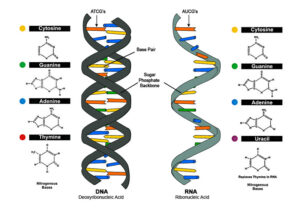RNA is a single strand molecule that is closely related to DNA. RNA strands have 4 nitrogenous bases which are guanine, adenine, uracil and cytosine. So how is RNA Antiparallel and what does it mean being in antiparallel orientation.
Is RNA Antiparallel, Yes. RNA strand being a single strand it is antiparallel in nature. RNA strands have 4 nitrogenous bases which are Guanine, Adenine, Uracil (in case of DNA, it is Thymine) and Cytosine. This article is completely highlighted on how the single stranded RNA is antiparallel in nature.
Now before getting into the topic- Is RNA antiparallel, we need to understand the basic structure of how the nitrogenous bases are combined or paired up so that understanding the concept of antiparallel RNA will be easy.
Basically in RNA there are 2 components that are purine and pyrimidine.
Adenine and Guanine are considered to be Purine whereas Uracil and Cytosine are considered to be pyrimidine.
So one Purine pair with one pyrimidine.
Adenine pairs up with uracil and cytosine pair up with guanine.

Image Credits: Flickr
What is antiparallel RNA?
To make this simple, parallel is when 2 lines are placed nearby and they do not intersect.
Antiparallel RNA strand is when the RNA strand is complementary to another strand and runs in the opposite direction: that is one strand runs from 5’ prime end to 3’ prime end and the other strand from 3’ prime end to 5’ prime end.
This can be in case of one genomic DNA and one synthesized RNA Strand or the other case is there can be structures in which the one single RNA strand folds itself and pairs into the same strand.
The synthesized RNA strand is antiparallel and complementary to the other strand.
Why does RNA have antiparallel strands?
RNA have antiparallel strands
If the RNA strands are parallel to the template strand the bonding of hydrogen is not possible.
We have already discussed that Adenine and Cytosine pairs with Uracil and Guanine respectively in RNA. This is possible only when the hydrogen bond is present. So in order to have them intact with all the nitrogenous pairs, sugars and phosphate they must run antiparallel.
Read More on Do Prokaryotes Have RNA: Why, How And Detailed Insights
Is RNA parallel?
No, in general be it DNA OR RNA they do not possess parallel orientation.
But in few cases, the DNA or RNA can fold into alternative structures and show up in parallel orientation which is rare and can not be taken into great consideration in science.
Read More on DNA Structure | A detailed insight with all crucial aspects
Frequently Asked Questions on Is RNA Antiparallel.
Why is RNA considered antiparallel strands?
We know that the sugar molecule and the phosphate is like the backbone of a RNA structure.
This is because of the pairing of nitrogenous bases. The Adenine and uracil pair up and the cytosine and guanine pair. So during this process the rna strand has to run through antiparallel orientation.
This is why RNA is considered an antiparallel strand.
Read More on DNA Supercoiling | A Vital Mechanism for DNA Packaging
Explanation on Structure of antiparallel RNA Strand

Image Credits: Wikimedia
- RNA is usually a single stranded component and it is made of specific nucleotides called the ribonucleotides that are held together by the phosphodiester bond.
- The ribonucleotides is composed of the sugar molecule that is specific for RNA known as ribose, it is a pentose sugar molecule, a nitrogenous base- any one from the four bases- Purine and pyrimidine (Adenine, uracil, guanine, cytosine) and the major backbone of this structure the phosphate group.
- The ultimate morphological difference between the sugars-deoxyribose in case of DNA, Ribose in case of RNA.
- The uracil is a pyrimidine compound that is observed only in RNA that pairs with adenine. (In the case of DNA, uracil is replaced by Thymine).
- Being a single stranded structure, RNA can show up intra intra-connective molecular structure by pairing of the bases among the same strand that is complementary and thus being antiparallel.
- This intra-connective molecular structure produces a clear three dimensional structure that does the required or targeted function.
- Meiosis Stages Unveiled: A Deep Dive into Cellular Division
- Mitosis Stages: A Comprehensive Guide for Understanding Cell Division
- Meiosis: Unraveling the Intricacies of Cellular Division
- Mitosis Explained: A Comprehensive Guide to Cell Division
- Mitosis vs Meiosis: Unveiling the Mystery of Cell Division
- Calvin Cycle: Unraveling the Secrets of Plant Photosynthesis
Also Read:
- Do bacteria have dna
- Cytoplasm
- Rhizome examples
- Are bacteria extracellular
- Artificial ecosystem example
- Ornamental plant example
- Coenzyme and holoenzyme
- Enzymes in digestion
- Cisternae in endoplasmic reticulum
- Is chromosome a chromatid

Hello, I am Sugaprabha Prasath, a Postgraduate in the field of Microbiology. I am an active member of the Indian association of applied microbiology (IAAM). I have research experience in preclinical (Zebrafish), bacterial enzymology, and nanotechnology. I have published 2 research articles in an International journal and a few more are yet to be published, 2 sequences were submitted to NCBI-GENBANK. I am good at clearly explaining the concepts in biology at both basic and advanced levels. My area of specialization is biotechnology, microbiology, enzymology, molecular biology, and pharmacovigilance. Apart from academics, I love gardening and being with plants and animals.
My LinkedIn profile-